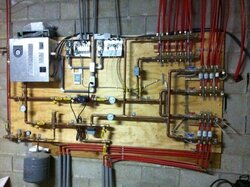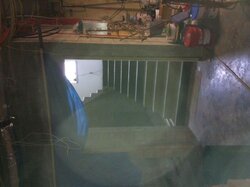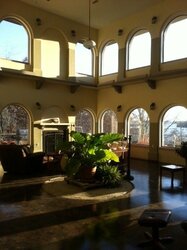Hello all, first post.
A little back ground; We are in the final stages of completing our new home. The home has ICF walls, (Insulated Concrete Forms) with concrete floors on steel bar joists. The rubber/concrete roof is flat with polyiso above and below, R-70
The home is 5000 sq-ft on a 3000 sq-ft basement. I know, way to big. It's a lake house with plans to attract the kids/grand kids back. There are two stories on the basement. It has a large open area to both levels 30' by 30'. All windows are triple pane with lots of glass to the South.
All the non basement floors are 4" slabs suspended, polyiso insulated from below. The floors have radiant tubes. There are 7 zones each with thermostats in air and slab. I had the system with zones to the guest rooms so they would be shut down during the off season. The radiant system was designed by NRT, an East coast design group. Good guys. The system has ele on demand boiler, with provisions for alternative heat source. I looked at solar as this source but IN is cloudy in the winter to often. So wood is the best solar energy here.
The house is also ducted for AC/ heat pump.
The radiant main manifold and control panel is located in the basement. The mechanical room is 16' by 16' with only other equipment in there is a water heater and air handeler. lots of room. Next to the mech room is the staircase and possible a good spot for storage. It is under a landing, size-> 5' by 5' by 11'.
In Southern Indiana, wood is plentiful. Mostly hardwoods. I work from home except when I need to travel. I think I have the perfect place for a wood boiler. Up to now, we have not used the radiant system. We have used the heat pump.
The flue will need to be external, about 30'.
I have lurked on this site for a couple of days and still have a few questions. I definitely will go with storage but trying to fully understand pressurised vs. non pressurised. If pressurised, you just plumb the boiler direct to the storage without a heat exchanger? And then the radiant system has a heat exchanger in the storage tank? My radiant panel has a thermostat controlled valve that allow the ele boiler to by pass the storage if below a set temp. The home demand is for water at 105 deg F. I assume if the storage tank is at 175 deg f, it allows mixing of the loop returns with the 175 deg water.
So if my assumption is correct about pressure system = no heat exchanger from boiler, what other advantages are there to go pressurized? I plan to have a large storage tank, I have room. I would prefer to have dedicated burns to build up the heat in the tank and let the fire go out.
We can and do have the power go out and some times for days. Last winter the power was out for 5 days, but we new it was coming due to an ice storm. (house temp only dropped 5 deg while the outside temps were in the teens). So that brings the next question; thermal siphoning. Does pressurized or not affect thermal siphoning? The tank will be at the same level as the boiler. Ideally, I'd like to have a battery backup to 1) have safety during a power outage and 2) actually have heat!
Ok with my first post with so much. here are a few photos. Radiant panel, proposed storage under stair landing and the sun room
Patrick T
A little back ground; We are in the final stages of completing our new home. The home has ICF walls, (Insulated Concrete Forms) with concrete floors on steel bar joists. The rubber/concrete roof is flat with polyiso above and below, R-70
The home is 5000 sq-ft on a 3000 sq-ft basement. I know, way to big. It's a lake house with plans to attract the kids/grand kids back. There are two stories on the basement. It has a large open area to both levels 30' by 30'. All windows are triple pane with lots of glass to the South.
All the non basement floors are 4" slabs suspended, polyiso insulated from below. The floors have radiant tubes. There are 7 zones each with thermostats in air and slab. I had the system with zones to the guest rooms so they would be shut down during the off season. The radiant system was designed by NRT, an East coast design group. Good guys. The system has ele on demand boiler, with provisions for alternative heat source. I looked at solar as this source but IN is cloudy in the winter to often. So wood is the best solar energy here.
The house is also ducted for AC/ heat pump.
The radiant main manifold and control panel is located in the basement. The mechanical room is 16' by 16' with only other equipment in there is a water heater and air handeler. lots of room. Next to the mech room is the staircase and possible a good spot for storage. It is under a landing, size-> 5' by 5' by 11'.
In Southern Indiana, wood is plentiful. Mostly hardwoods. I work from home except when I need to travel. I think I have the perfect place for a wood boiler. Up to now, we have not used the radiant system. We have used the heat pump.
The flue will need to be external, about 30'.
I have lurked on this site for a couple of days and still have a few questions. I definitely will go with storage but trying to fully understand pressurised vs. non pressurised. If pressurised, you just plumb the boiler direct to the storage without a heat exchanger? And then the radiant system has a heat exchanger in the storage tank? My radiant panel has a thermostat controlled valve that allow the ele boiler to by pass the storage if below a set temp. The home demand is for water at 105 deg F. I assume if the storage tank is at 175 deg f, it allows mixing of the loop returns with the 175 deg water.
So if my assumption is correct about pressure system = no heat exchanger from boiler, what other advantages are there to go pressurized? I plan to have a large storage tank, I have room. I would prefer to have dedicated burns to build up the heat in the tank and let the fire go out.
We can and do have the power go out and some times for days. Last winter the power was out for 5 days, but we new it was coming due to an ice storm. (house temp only dropped 5 deg while the outside temps were in the teens). So that brings the next question; thermal siphoning. Does pressurized or not affect thermal siphoning? The tank will be at the same level as the boiler. Ideally, I'd like to have a battery backup to 1) have safety during a power outage and 2) actually have heat!
Ok with my first post with so much. here are a few photos. Radiant panel, proposed storage under stair landing and the sun room
Patrick T




